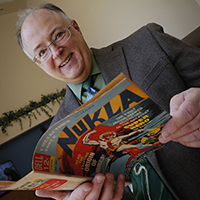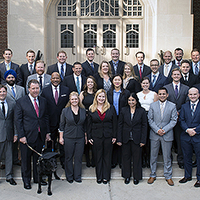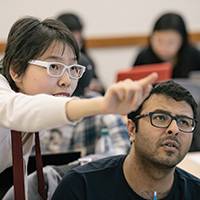 Learn more about benefits of the Krannert Weekend MBA program from students and alumni.
Learn more about benefits of the Krannert Weekend MBA program from students and alumni.
Hybrid Teaching, Transformative Learning
Redesigned Weekend MBA program blends online and classroom pedagogy
Purdue’s recently restructured Weekend MBA program has boosted master’s degree enrollment and earned awards for a veteran Krannert professor and two instructional designers from ITaP. But the real winners behind the innovations in teaching and learning technologies are students.
Introduced in 2016, the 21-month hybrid program features two-thirds on-campus instruction and one-third online work, meaning participants need to travel to campus only twice a month for classes. Under the new format, students take two classes at a time and have sessions from 8 a.m. to 5 p.m. every other Saturday. In the old format, students met on Fridays and Saturdays every other week.
The genesis for an in-class and online hybrid arose from the demands on today’s MBA student, says Don Roush, the program’s associate director.
“A lot of our students have traditionally been working professionals, often with young families, who live within a couple of hours’ drive from West Lafayette,” Roush says. “If you’re working all week, then having to drive to campus to take classes every weekend, that’s really difficult for a lot of people. We knew there had to be a better way.”
But rather than enter the fray with the several hundred MBA programs now available entirely online, Roush says, Krannert wanted to keep providing a classroom setting where students could meet face-to-face with professors and peers and where networking would remain a key component.
“There’s a lot of value in being able to have that face-to-face time, both with the professor and with the other students,” Roush says.
Roush and his team turned to ITaP and the instructional designers working for its Teaching and Learning Technologies unit, looking for help with a simple request: Create a hybrid weekend program that required students to be on campus two Saturdays a month, but where a significant portion of the learning could take place online.
“Initially there were concerns from faculty that they would lose time for discussion,” says ITaP instructional designer Erica Vail, who helped lead the course design process. “And there was a learning curve with some of the technology.”
But creating a hybrid degree program with a major online component goes far beyond setting faculty up with the right technology or recording lecture videos. For Vail and her team, it meant working with faculty to ensure their transition from traditional to online classroom was both smooth and pedagogically sound — looking at everything from how students would navigate online discussions and assignments, to determining what metrics should be used to measure success.






